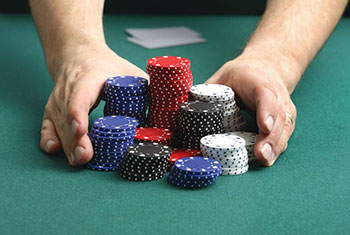BETTING IT RIGHT
Making the most of a value bet
By Jack Clayton
 Knowing how much to invest in a stock at the right time is essential money management. You don’t jump into the market just to have action in the financial world, but to turn that investment into a profit. The same rules apply at the poker tables. Poker profit hinges on timing by making the correct wager and size of your bet.
Knowing how much to invest in a stock at the right time is essential money management. You don’t jump into the market just to have action in the financial world, but to turn that investment into a profit. The same rules apply at the poker tables. Poker profit hinges on timing by making the correct wager and size of your bet.
Let’s start with what not to do. Novice players often make an incorrect size of a bet at the wrong times. Instead of thinking carefully about how many chips to toss into the pot they mash the bet-pot button or just wager any amount without proper consideration. Instead, make each bet the right amount utilizing mathematics.
Know you limit and know your goal. A good player asks “Is this a proper value bet, or am I just hoping the opponent folds?” Because if they don’t do what you expect you could be in too deep and set up for a serious financial fall with the odds working against you.
Look at it this way: Have a purpose and a plan on every hand. Rather than playing for the sake of being in the game, or hoping the cards go your way, think carefully about what you want to accomplish with each hand. An astute player thinks about the short and long term with what’s at stake financially. On the one hand, you want to add to the pot or fold when the odds are for or against you, which means handling your chips with great care. This means discipline, playing the correct amount.
At the same time, you want to have a little flexibility, too, meaning you don’t want to become predictable in your wagering or playing patterns, so there is leeway for a little finesse and unpredictability. Good opponents will pick up on your patterns and use them against you.
Let’s say your goal is to get an opponent to fold. If you raise pre- flop in position and are called, and you wish to make a continuation bet, there’s no reason to bet the whole pot.
Often a half-to two-thirds-pot bet can accomplish this while risking fewer chips. Most of the time the opponent will fold to the smaller bet just as often as they will to a full pot-size bet. If your opponent is set on calling, they are going to call no matter what the bet size. So by learning to wagering a smaller amount, you protect an asset (chips) when you are called.
When you are making a wager that you want to get called, that is a value bet. The purpose is that you have the better hand and you are expecting your opponent to pay you off with a worse one.
In addition, make sure you know who you are playing against. Taking time to analyze and size-up your opponents is essential. Looking for the tendencies, patterns, style of play will help you assess who the sharps are and who the fish are. Some players think an over-bet equals a bluff on your part, while others believe an over-bet means you have the best hand (the “nuts”). An astute player begins categorizing opponents the moment they sit down.
One Vegas player I know is loud at the table, talkative, even nudging the person next to them like they are old buddies. The purpose is to throw that person off their game, shake them up a bit, and then take advantage later. This is one sign that a person is an experienced player who knows what they’re doing.
Always pay attention and use the information you’ve gained throughout your session to decide who you’re up against and what bet size is going to make you the most cash. If you’re trying a new strategy at the table, which is common as you learn the game, don’t be afraid to drop your limits during the testing and learning phase. Knowing money management and bet-size are just as important as knowing your cards.


